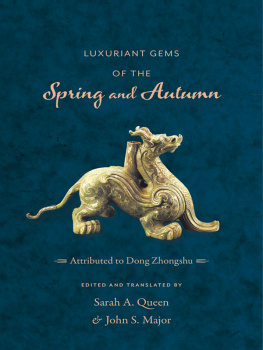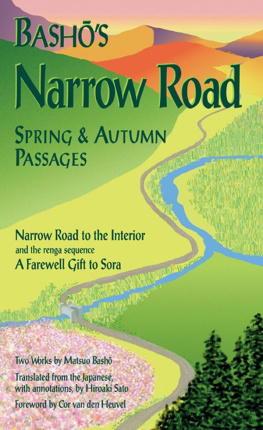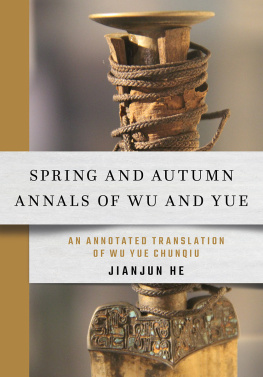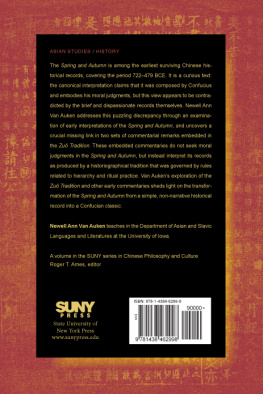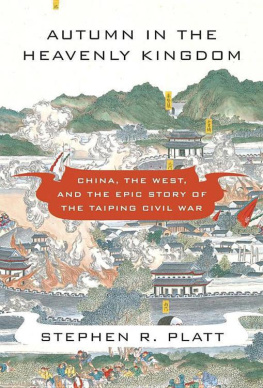LUXURIANT GEMS OF THE
Spring and Autumn
TRANSLATIONS FROM THE ASIAN CLASSICS
TRANSLATIONS FROM THE ASIAN CLASSICS
EDITORIAL BOARD
Wm. Theodore de Bary, Chair
Paul Anderer
Donald Keene
George A. Saliba
Haruo Shirane
Burton Watson
Wei Shang
LUXURIANT GEMS OF THE
Spring and Autumn

Attributed to Dong Zhongshu

EDITED AND TRANSLATED BY
Sarah A. Queen
& John S. Major
Columbia University Press New York
Columbia University Press
Publishers Since 1893
New York Chichester, West Sussex
cup.columbia.edu
Copyright 2016 Columbia University Press
All rights reserved
E-ISBN 978-0-231-53961-6
Columbia University Press wishes to express its appreciation for assistance given by the Chiang Ching-kuo Foundation for International Scholarly Exchange in the preparation of the translation and in the publication of this series.
Library of Congress Cataloging-in-Publication Data
Names: Dong, Zhongshu, active 2nd century B.C. |
Queen, Sarah A. (Sarah Ann) editor. | Major, John S., editor.
Title: Luxuriant gems of the spring and autumn ; attributed to Dong Zhongshu ;
edited and translated by Sarah A. Queen and John S. Major.
Other titles: Chun qiu fan lu. English
Description: New York : Columbia University Press, [2016] |
Series: Translations from the Asian classics | Includes bibliographical references and index.
Identifiers: LCCN 2015008489| ISBN 9780231169325 (cloth : acid-free paper) |
ISBN 9780231539616 (e-book)
Classification: LCC PL2470.Z7 D6613 2016 | DDC 931/.03dc23
LC record available at http://lccn.loc.gov/2015008489
A Columbia University Press E-book.
CUP would be pleased to hear about your reading experience with this e-book at .
COVER IMAGE: Bronze base for a bell rack in the form of a dragon, from the tomb of Liu Fei, king of Jiangdu, whom Dong Zhongshu served as administrator in the 130s B.C.E. (Photo courtesy of the Archaeological Research Institute, Nanjing Museum)
COVER & BOOK DESIGN: Lisa Hamm
For Thomas and Benjamin, and for Steve
Contents
W E ARE grateful to the many friends and colleagues who gave us encouragement and good advice during the years it took us to complete this book. Joachim Gentz and Newell Ann van Auken very generously shared perspectives on the Spring and Autumn and its commentaries. Michael Loewe kindly shared information from his book-length study of Dong Zhongshu in advance of its publication in 2011. We are grateful to David Pankenier for generously sharing with us his notes from a reading of the Chunqiu fanlu with the legendary scholar and teacher Aisin-gioro Yu-yun. The anonymous peer reviewers for Columbia University Press made many helpful suggestions for improving the manuscript. Nathan Sivin did us a huge favor by reading a complete but still rough draft of the entire manuscript, providing us with a detailed critique of the work as a whole and suggesting hundreds of specific corrections. We are grateful to Nancy Lewandowski for her management of successive digital and physical copies of the manuscript.
Jennifer Crewe, Jonathan Fiedler, Irene Pavitt, Lisa Hamm, and their colleagues at Columbia University Press worked with consummate professionalism on the editing, design, and production of the book. Anne Holmes worked her customary magic on the books index. Our thanks to all of them.
We owe a tremendous debt of gratitude to Graham Majorhart for his tenacity and excellent negotiating skills in tracking down and obtaining for us the beautiful image that graces the cover of this book. Thanks also are due to Mr. Chen Xingcan, deputy director of the Institute of Archaeology, Chinese Academy of Social Sciences, who facilitated Grahams initial contact with the relevant authorities, and especially to Mr. Lin Liugen, director of the Archaeological Research Institute at the Nanjing Museum, who provided the actual image and permission to use it. We are delighted that, through their efforts and goodwill, we are able to use on the cover of this book the image of a cast-bronze dragon that was found in the recently excavated tomb of Liu Fei, king of Jiangdu (r. 153128 B.C.E.). Dong Zhongshu, the putative author of the Chunqiu fanlu (and the actual author of some of it), served as administrator of Jiangdu during the 130s B.C.E., and it is a remarkable privilege to be able to adorn this books cover with an objectthe base of a bell-rackthat Dong may well have seen in use in Liu Feis court.
As always, we owe deepest thanks to our respective families for their encouragement, support, and forbearance.
By the beginning of the Han dynasty (206 B.C.E.220 C.E.), many intellectuals had come to believe that the Spring and Autumn had been written or edited by Confucius himself, using an esoteric language of praise and blame to indicate approval or disapproval of the recorded historical events. The chronicle therefore was viewed as a canonical source of guidance for rulers and their ministers. In fact, though, the Chunqiu fanlu is a collection of very disparate materials, composed by several people over a period spanning several generations. Some of its content does indeed rely on, or at least refer to, the Spring and Autumn as a fountainhead of prescriptive wisdom, but in some chapters this connection is tangential or absent.
Fate has not been kind to this text. Many of its chapters are fragmentary and garbled, and over the centuries, scholars have questioned the authenticity of the text, or parts of it. The factors conspiring against scholarly acceptance of the Chunqiu fanlu have been numerous and compelling. The texts late appearance on the literary scene, its inclusion of materials that clearly postdate Dongs life, and the poor quality of the collectionwith respect to both its literary style and the condition of the various editions that have survivedhave led some readers to treat it dismissively and have challenged those scholars who have attempted to understand, interpret, and defend it. In turn, the questionable authenticity of the text has cast a long shadow over the figure of Dong Zhongshu himself.
A Brief Biography of Dong Zhongshu
What little we know about Dong Zhongshu comes from two accounts of his life preserved in the Han official histories: the chapter The Biographies of Confucian Scholars in the Shiji and the Biography of Dong Zhongshu in the Han shu. The latter biography draws on its Shiji predecessor but expands on it by including a number of Dongs official communications and other writings. Appendices A and B at the end of this volume contain full translations of these two biographies. By way of background, we briefly summarize here some of the most important events in Dongs life.
and that at an early age he mastered the Spring and Autumn. The circumstances under which he was able to do this and who served as his teacher are not described. In short, the details of Dongs early life remain beyond the historians reach.

